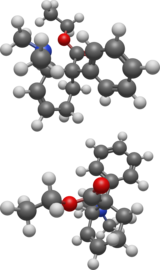 (1S,2R)-tilidine (dextilidine; top), (1R,2S)-tilidine (bottom) [skeletal diagram 2D] | |
 (1S,2R)-tilidine (dextilidine; top), (1R,2S)-tilidine (bottom) [ball-and-stick diagram 3D] | |
| Clinical data | |
|---|---|
| Trade names | Valoron, others |
| Other names | Tilidate (BAN UK) |
| AHFS/Drugs.com | International Drug Names |
| Routes of administration | By mouth, rectal, intramuscular, intravenous |
| Drug class | Opioid |
| ATC code | |
| Legal status | |
| Legal status |
|
| Pharmacokinetic data | |
| Bioavailability | 6% (parent compound), 99% (active metabolite)[2] |
| Metabolism | Metabolized by the liver, mostly via the enzymes CYP3A4 and CYP2C19[3] |
| Onset of action | 10–15 minutes |
| Elimination half-life | 3–5 hours[3] |
| Duration of action | 4–6 hours |
| Excretion | Urine (90%)[3] |
| Identifiers | |
| |
| CAS Number | |
| DrugBank | |
| UNII | |
| KEGG | |
| ChEBI | |
| ChEMBL | |
| ECHA InfoCard | 100.039.779 |
| Chemical and physical data | |
| Formula | C17H23NO2 |
| Molar mass | 273.376 g·mol−1 |
| 3D model (JSmol) | |
| |
| | |
Tilidine, sold under the brand name Valoron among others, is a synthetic opioid analgesic, used mainly in Belgium, Bulgaria, Germany, Albania, Luxembourg, South Africa, and Switzerland for the treatment of moderate to severe pain, both acute and chronic.[4][5] Its onset of pain relief after oral administration is about 10–15 minutes and peak relief from pain occurs about 25–50 minutes after administration.[3]
- ^ Anvisa (2023-03-31). "RDC Nº 784 - Listas de Substâncias Entorpecentes, Psicotrópicas, Precursoras e Outras sob Controle Especial" [Collegiate Board Resolution No. 784 - Lists of Narcotic, Psychotropic, Precursor, and Other Substances under Special Control] (in Brazilian Portuguese). Diário Oficial da União (published 2023-04-04). Archived from the original on 2023-08-03. Retrieved 2023-08-16.
- ^ Vollmer KO, Thomann P, Hengy H (October 1989). "Pharmacokinetics of tilidine and metabolites in man". Arzneimittel-Forschung. 39 (10): 1283–8. PMID 2610722.
- ^ a b c d "Tilidin N Sandoz® DP Lösung zum Einnehmen" [Tilidin N Sandoz ® DP oral solution] (PDF) (in German). Wooden Churches: Sandoz Pharmaceuticals GmbH. December 2012. Archived from the original (PDF) on 2 May 2014. Retrieved 18 April 2014.
- ^ Brayfield A, ed. (13 December 2013). "Tilidine Hydrochloride". Martindale: The Complete Drug Reference. Pharmaceutical Press. Retrieved 18 April 2014.
- ^ "Tilidine". Drugs.com. Retrieved 8 February 2020.